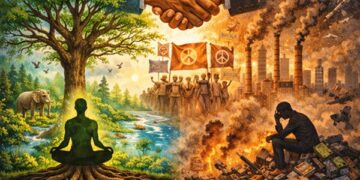By: Fahid Fayaz Darangay
This World Band data severely exposes the medical infrastructure of India. We are not even competitive with our neighboring less developing countries. This data shows that India had 85.7 physicians per 1,00,000 people in 2017 (in contrast to 98 in Pakistan, 58 in Bangladesh, 100 in Sri Lanka and 241 in Japan), 53 beds per 1,00,000 people (in contrast to 63 in Pakistan, 79.5 in Bangladesh, 415 in Sri Lanka and 1,298 in Japan), and 172.7 nurses and midwives per 1,00,000 people (in contrast to 220 in Sri Lanka, 40 in Bangladesh, 70 in Pakistan, and 1,220 in Japan). That remains the so far the most debated question through this terrible ongoing second wave of Covid-19 in India which totally devastated the major population of India. Every state except some southern states , every village got impacted by this wave.
The reason for the poor health infrastructure may be the distributional erroneousness in the allocation of the health expenditure as a part of total GDP. In fiscal year 2018, the value of public health expenditure by states and union territories together amounted to around 1.58 trillion Indian rupees. This was estimated to be around 1.28 to 3 percent of the country’s GDP. In comparison, the United States’ budget estimates showed an outlay of over 17 percent of the GDP to public health expenditure in its fiscal year 2018. Overall, India’s per capita expenditure on health amounted to over 1,600 Indian rupees that same year. However, this was an average estimate with some parts of the country focusing on health far more than others. For example, the larger and wealthier states like Maharashtra and Uttar Pradesh spent between 120 to 180 billion rupees on health in fiscal year 2018; whereas north-eastern states which have historically been poorer and more remote, spent around three to six billion rupees on healthcare that year.
Second Wave Economy:
The nationwide lockdown last year in response to the first wave of the pandemic resulted in a severe supply shock. What India is seeing now is not a severe supply shock but a demand shock. The second wave, as it is highly transmissible and ferocious as compared to the first wave, has created a lot of uncertainty, pessimism and loss of confidence among households and businesses. It will take time for people to start recovering because it has created a lot of uncertainty. So, that’s the key difference between the first and second waves. The second wave also affects supply to some extent, but it is primarily a demand shock. Last year, what we saw was that during the first quarter, savings increased as people were not able to spend because of the lockdown. But in the second quarter, we saw that savings declined and consumption spending picked up. It is difficult to say whether that will repeat this time. So, we might not see a steep V-shaped recovery that we saw last time.
According to the Centre for Monitoring Indian Economy — a think tank — the unemployment rate grew from 6% in March to 8% in April. Studies show that more than 200 million Indians are expected to fall into poverty as a result of shutdowns and healthcare costs. The S&P has now downgraded Indian GDP growth to 9.8%.
Most experts predict the second wave to recede by June. But the government has to start now to rebuild the economy. There are three parts to this. The most immediate involve.
Government spending must then follow. At the end of 2019, the government released a National Infrastructure Pipeline, outlining capital expenditures of Rs. 120 trillion over five years. The announcement ran into the onset of the pandemic but this program should be expedited. With a gradual glide path to 3% fiscal deficit signaled in the union budget and buoyant direct and indirect tax collections, the government has fiscal headroom for this expansionary spend.
The writer is Honours in Economics from Aligarh Muslim University.





